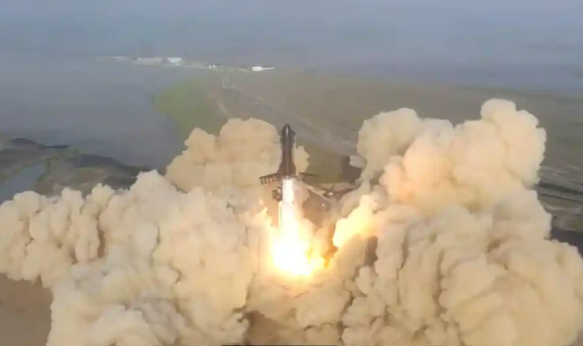Elon Musk’s Starship rocket, which is the largest and most powerful rocket ever built, was launched from Texas but ended up exploding after just three minutes. It was the first test run for the SpaceX rocket, which was created with the sole purpose of fulfilling the Twitter CEO’s dream of putting the first-ever human on Mars.
The 120-metre Starship rocket system was launched at 8:33 am local time on Thursday after an initial launch was canceled earlier this week due to a pressurization issue. The rocket began to spin at altitude after gathering speed but ended up exploding just minutes after leaving the ground.
Also Read | Did Elon Musk have neck scar during Tucker Carlson’s interview?
The cause of the blast was reported to be because the two sections of the rocket system, namely, the booster and cruise vessel, were unable to separate properly after takeoff.
A video of the takeoff was also posted by the official Twitter channel of SpaceX:
Liftoff of Starship! pic.twitter.com/4t8mRP37Gp
— SpaceX (@SpaceX) April 20, 2023
How much did Starship rocket cost to build?
Musk had initially disclosed that the development cost of the Starship project was between $2 billion and $10 billion. However, After making significant changes to its design, Musk disclosed during an interview for CNN Business that the estimated cost of the project had fallen to much lower. “Probably closer to two or three [billion] than it is to 10 [billion],” he said.
One of the reasons the estimated cost was put at a much higher rate is that SpaceX was planning to build the Starship vehicle out of carbon fiber. However, in January 2019, Musk announced the crucial decision to change to stainless steel instead. He said that the vital decision was made because steel is heavier than carbon fiber but has thermal properties and of course, is cheaper.
The goal of the Starship rocket is to enter the Earth’s Orbit and come back down to Earth for a vertical, propulsive landing. “This is the fastest path to a self-sustaining city on Mars,” Musk said in September 2019.
The greater plan is to send 1,000 or more people to Mars every 26 months with the goal of establishing a million-person city on the Red Planet within the next 100 years.







